Performance Evaluation of a Double-Helical-Type-Channel Reinforced Heat Sink Based on Energy and Entropy-Generation Analysis
Abstract
1. Introduction
2. Numerical Details
2.1. Physical Model
2.2. Governing Equations and Boundary Conditions
2.3. Grid Independence
3. Experimental Details
3.1. Experimental Setup
3.2. Processing of Data
3.2.1. Thermal-Performance Evaluation
3.2.2. Hydraulic-Performance Evaluation
3.2.3. Comprehensive Performance Assessment
3.3. Numerical Model Validation and Uncertainty Analysis
4. Results and Discussion
4.1. Basic Performance Analysis
4.1.1. Thermal-Performance Analysis
4.1.2. Hydraulic-Performance Analysis
4.2. Comprehensive Performance Analysis
4.2.1. Performance Evaluation
4.2.2. Analysis of Entropy Generation
5. Conclusions
- (1)
- Channels with ribbed construction outperform SFC in terms of thermal performance. However, diamond and rectangular ribs have little influence in boosting the heat sink’s thermal performance. The elliptic, drop-shaped and frustum ribs considerably increase the heat sink’s heat-transmission performance. FC-ER offers the lowest average temperature and the highest temperature uniformity, with a Nusselt number improvement percentage ranging from 15.80% to 30.77%.
- (2)
- The inlet and outlet pressure drops and the friction factor of the rib structure flow channel are larger than those of the SFC.
- (3)
- For the smooth flow channel, it is more effective to improve the comprehensive performance by arranging elliptic, drop-shaped and frustum ribs. FC-ER provides the best balance between enhanced heat transfer and flow losses over the range of Reynolds numbers studied.
- (4)
- For all flow channels with ribbed structures, the augmentation entropy-generation number is below one. From the viewpoint of entropy generation, flow channels with ribbed structures are all superior to SFC. In generally, FC-ER has the smallest augmentation entropy-generation number, which means the least loss of available energy for the same gain.
Author Contributions
Funding
Data Availability Statement
Conflicts of Interest
Nomenclature
| Variables | |
| A | area (m2) |
| Cp | specific heat capacity (J/(kg*k)) |
| Dh | hydraulic diameter (m) |
| h | heat-transfer coefficient (W/m2*K) |
| Hc | height of the channel (m) |
| Lch | length of the flow channel (m) |
| mass flow rate (kg/s) | |
| Ns | the augmentation entropy-generation number |
| Nu | Nusselt number |
| P | pressure (Pa) |
| Q | heat-transfer gain(W) |
| Re | Reynolds number |
| Sg | the total entropy-generation rate (W/ K) |
| T | Temperature (°C) |
| u | flow velocity (m/s) |
| u,v,w | velocity at the x, y z directions, respectively (m/s); |
| x,y,z | Cartesian coordinates; |
| Greek symbols | |
| λ | fluid thermal conductivity (W/m*K) |
| μ | fluid dynamic viscosity (Pa*s) |
| ρ | density (kg/m3) |
| friction factor | |
| ΔP | pressure drop (Pa) |
| ΔT | temperature non-uniformity (°C) |
| Subscripts | |
| f | fluid |
| R | ribbed |
| S | original |
| w | wall |
| in | inlet |
| ave | average |
References
- Anandan, S.S.; Ramalingam, V. Thermal Management of Electronics: A review of Literature. Therm. Sci. 2008, 12, 5–26. [Google Scholar] [CrossRef]
- Huai, W.; Liserre, M.; Blaabjerg, F. Toward Reliable Power Electronics: Challenges, Design Tools, and Opportunities. IEEE Ind. Electron. Mag. 2013, 7, 17–26. [Google Scholar]
- Ui-Min, C.; Blaabjerg, F.; Kyo-Beum, L. Study and Handling Methods of Power IGBT Module Failures in Power Electronic Converter Systems. IEEE Trans. Power Electron. 2015, 30, 2517–2533. [Google Scholar]
- Mohammadian, S.K.; Zhang, Y. Thermal management optimization of an air-cooled Li-ion battery module using pin-fin heat sinks for hybrid electric vehicles. J. Power Sources 2015, 273, 431–439. [Google Scholar] [CrossRef]
- Teng, H.; Yeow, K. Design of direct and indirect liquid cooling systems for high-capacity, high-power lithium-ion battery packs. SAE Int. J. Altern. Powertrains 2012, 1, 525–531. [Google Scholar] [CrossRef]
- Yeo, D.Y.; No, H.C. Modeling film boiling within chimney-structured porous media and heat pipes. Int. J. Heat Mass Transf. 2018, 124, 576–585. [Google Scholar] [CrossRef]
- Mira-Hernandez, C.; Clark, M.D.; Weibel, J.A.; Garimella, S.V. Development and validation of a semi-empirical model for two-phase heat transfer from arrays of impinging jets. Int. J. Heat Mass Transf. 2018, 124, 782–793. [Google Scholar] [CrossRef]
- Lyu, Y.; Siddique, A.R.M.; Majid, S.H.; Biglarbegian, M.; Gadsden, S.A.; Mahmud, S. Electric vehicle battery thermal management system with thermoelectric cooling. Energy Rep. 2019, 5, 822–827. [Google Scholar] [CrossRef]
- Bilen, K.; Cetin, M.; Gul, H. The investigation of groove geometry effect on heat transfer for internally grooved tubes. Appl. Therm. Eng. 2009, 29, 753–761. [Google Scholar] [CrossRef]
- Mesalhy; Aziz, S.S.A.; El-Sayed, M.M. Flow and heat transfer over shallow cavities. Int. J. Thermal. Sci. 2021, 49, 514–521. [Google Scholar] [CrossRef]
- Chai, L.; Xia, G.D.; Zhou, M.Z. Numerical simulation of fluid flow and heat transfer in a microchannel heat sink with offset fan-shaped reentrant cavities in sidewall. Int. Commun. Heat Mass Transf. 2011, 38, 577–584. [Google Scholar] [CrossRef]
- Zhou, J.; Hatami, M.; Song, D. Design of microchannel heat sink with wary channel and its time-efficient optimization with combined RSM and method. Int. J. Heat Mass Tran. 2016, 103, 715–724. [Google Scholar] [CrossRef]
- Mohammed, H.A.; Gunnasegaran, P.; Shuaib, N.H. Influence of channel shape on the thermal and hydraulic performance of microchannel heat sink. Int. Commun. Heat Mass Transfer. 2011, 38, 474–480. [Google Scholar] [CrossRef]
- Mohammed, H.A.; Gunnasegaran, P.; Shuaib, N.H. Numerical simulation of heat transfer enhancement in wavy microchannel heat sink. Int. Commun. Heat Mass Transfer. 2011, 38, 63–68. [Google Scholar] [CrossRef]
- Hua, J.; Li, G.; Zhao, X.; Li, Q.; Hu, J. Study on the flow resistance performance of fluid cross various shapes of micro-scale pin fin. Appl. Therm. Eng. 2016, 107, 768–775. [Google Scholar] [CrossRef]
- Xie, G.; Liu, X.; Yan, H.; Qin, J. Turbulent flow characteristics and heat transfer enhancement in a square channel with various crescent ribs on one wall. Int. J. Heat Mass Transf. 2017, 115, 283–295. [Google Scholar] [CrossRef]
- Gholami, M.R.; Akbari, O.A.; Marzban, A. The effect of rib shape on the behavior of laminar flow of oil/MWCNT nanofluid in a rectangular microchannel. J. Therm. Anal. Calorim. 2017, 134, 1611–1628. [Google Scholar] [CrossRef]
- Chai, L.; Xia, G.D.; Wang, H.S. Numerical study of laminar flow and heat transfer in microchannel heat sink with offset ribs on sidewalls. Appl. Therm. Eng. 2016, 92, 32–41. [Google Scholar] [CrossRef]
- Jaffal, H.M.; Mahmoud, N.S.; Imran, A.A.; Hasan, A. Performance enhancement of a novel serpentine channel cooled plate used for cooling of Li-ion battery module. Int. J. Therm. Sci. 2023, 184, 107955. [Google Scholar] [CrossRef]
- Bejan, A.; Pfister, P.A. Evaluation of heat transfer augmentation techniques based on their impact on entropy generation. Lett. Heat Mass Transf. 1980, 7, 97–106. [Google Scholar] [CrossRef]
- He, Y.-L.; Tang, S.-Z.; Tao, W.-Q.; Li, M.-J.; Wang, F.-L. A general and rapid method for performance evaluation of enhanced heat transfer techniques. Int. J. Heat Mass Tran. 2019, 145, 118780. [Google Scholar] [CrossRef]
- Liu, W.; Liu, P.; Wang, J.B. Exergy destruction minimization: A principle to convective heat transfer enhancement. Int. J. Heat Mass Tran. 2018, 122, 11–21. [Google Scholar] [CrossRef]
- Ji, W.T.; Jacobi, A.M.; He, Y.L. Summary and evaluation on single-phase heat transfer enhancement techniques of liquid laminar and turbulent pipe flow. Int. J. Heat Mass Tran. 2015, 88, 735–754. [Google Scholar] [CrossRef]
- Wang, F.; Wang, G. Heat transfer augmentation and entropy generation analysis of a helically coiled tube with internal longitudinal fins. Chem. Eng. Technol. 2011, 34, 1876–1882. [Google Scholar] [CrossRef]
- Datta, V.; Sharma, D.; Sanyal. A conjugate heat transfer analysis of performance for rectangular microchannel with trapezoidal cavities and ribs. Int. J. Therm. Sci. 2019, 138, 425–446. [Google Scholar] [CrossRef]
- Guo, K.; Li, Q.; Liu, B.T. A novel design method based on flow pattern construction for flow passage with low flow drag and pressure drop. Chem. Eng. Sci. 2015, 135, 89–99. [Google Scholar] [CrossRef]
- Guo, K.; Liu, B.T.; Li, X. Flow pattern construction-based tubular heat transfer intensification using calculus of variations. Chem. Eng. Sci. 2016, 152, 568–578. [Google Scholar] [CrossRef]
- Guo, K.; Qi, W.Z.; Liu, B.T. Optimization of an “area to point” heat conduction problem. App. Therm. Eng. 2016, 93, 61–71. [Google Scholar] [CrossRef]
- Zhao, N.; Guo, L.; Qi, C.; Chen, T.; Cui, X. Experimental study on thermo-hydraulic performance of nanofluids in CPU heat sink with rectangular grooves and cylindrical bugles based on exergy efficiency. Energy Convers. Manag. 2019, 181, 235–246. [Google Scholar] [CrossRef]
- Zhao, N.; Qi, C.; Chen, T.; Tang, J.; Cui, X. Experimental study on influences of cylindrical grooves on thermal efficiency, exergy efficiency and entropy generation of CPU cooled by nanofluids. Int. J. Heat Mass Transf. 2019, 135, 16–32. [Google Scholar] [CrossRef]
- Khalifa, M.A.; Jaffal, H.M. Effects of channel configuration on hydrothermal performance of the cylindrical mini-channel heat sinks. Appl. Therm. Eng. 2019, 148, 1107–1130. [Google Scholar] [CrossRef]
- He, L.; Hu, X.; Zhang, L. Performance Evaluation and Optimization of Series Flow Channel Water-Cooled Plate for IGBT Modules. Energies 2023, 16, 5205. [Google Scholar] [CrossRef]
- Xie, X.L.; Tao, W.Q.; He, Y.L. Numerical Study of Turbulent Heat Transfer and Pressure Drop Characteristics in a Water-Cooled Minichannel Heat Sink. J. Electron. Packag. 2017, 129, 247–255. [Google Scholar] [CrossRef]
- Webb, R.L. Performance evaluation criteria for use of enhanced heat transfer surfaces in heat exchanger design. Int. J. Heat Mass Transf. 1981, 24, 715–726. [Google Scholar] [CrossRef]
- Xia, G.D.; Zhai, Y.L.; Cui, Z.Z. Characteristics of entropy generation and heat transfer in a microchannel with fan-shaped reentrant cavities and internal ribs. Sci. China Technol. Sci. 2013, 56, 1629–1635. [Google Scholar] [CrossRef]
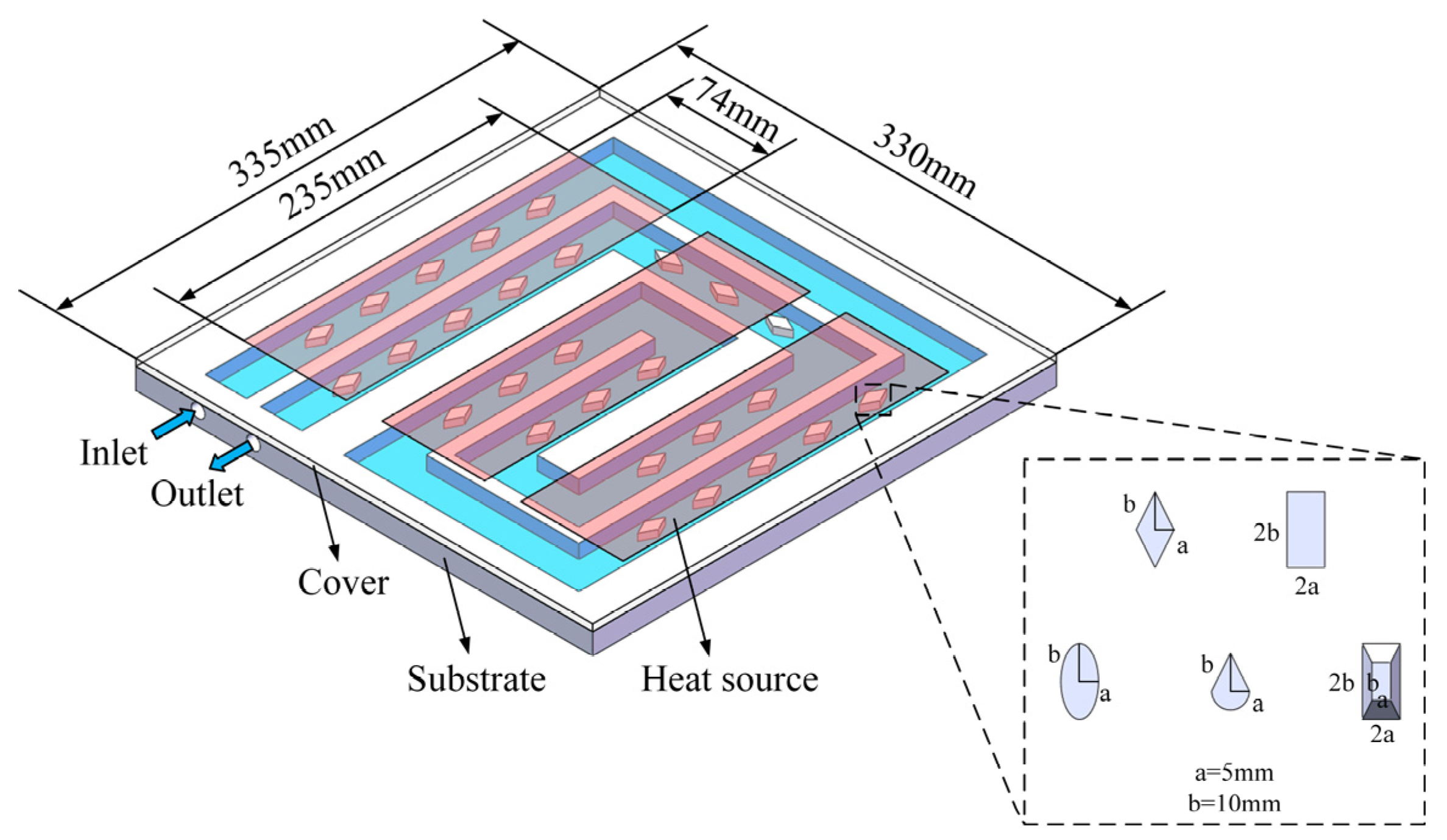

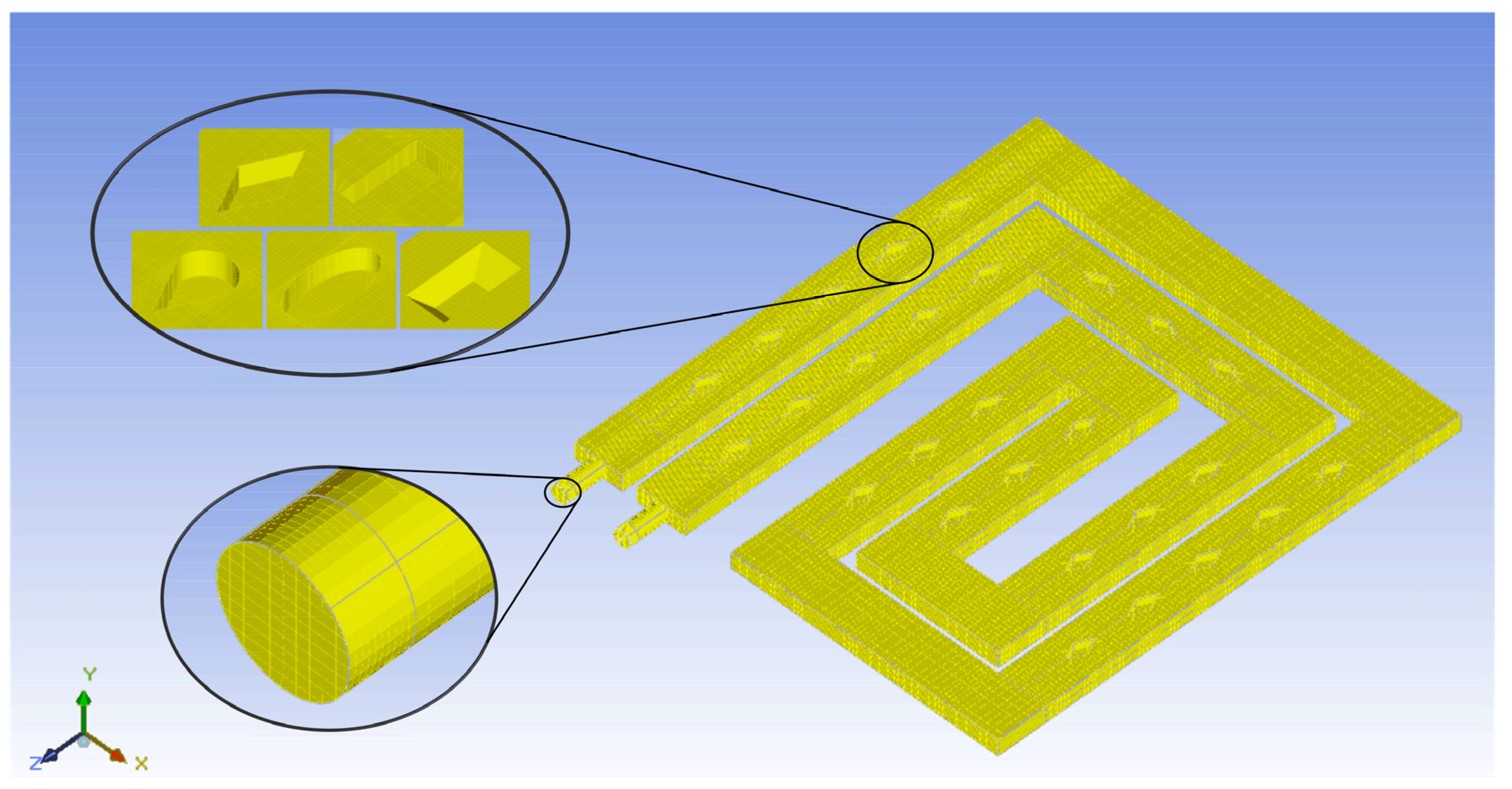
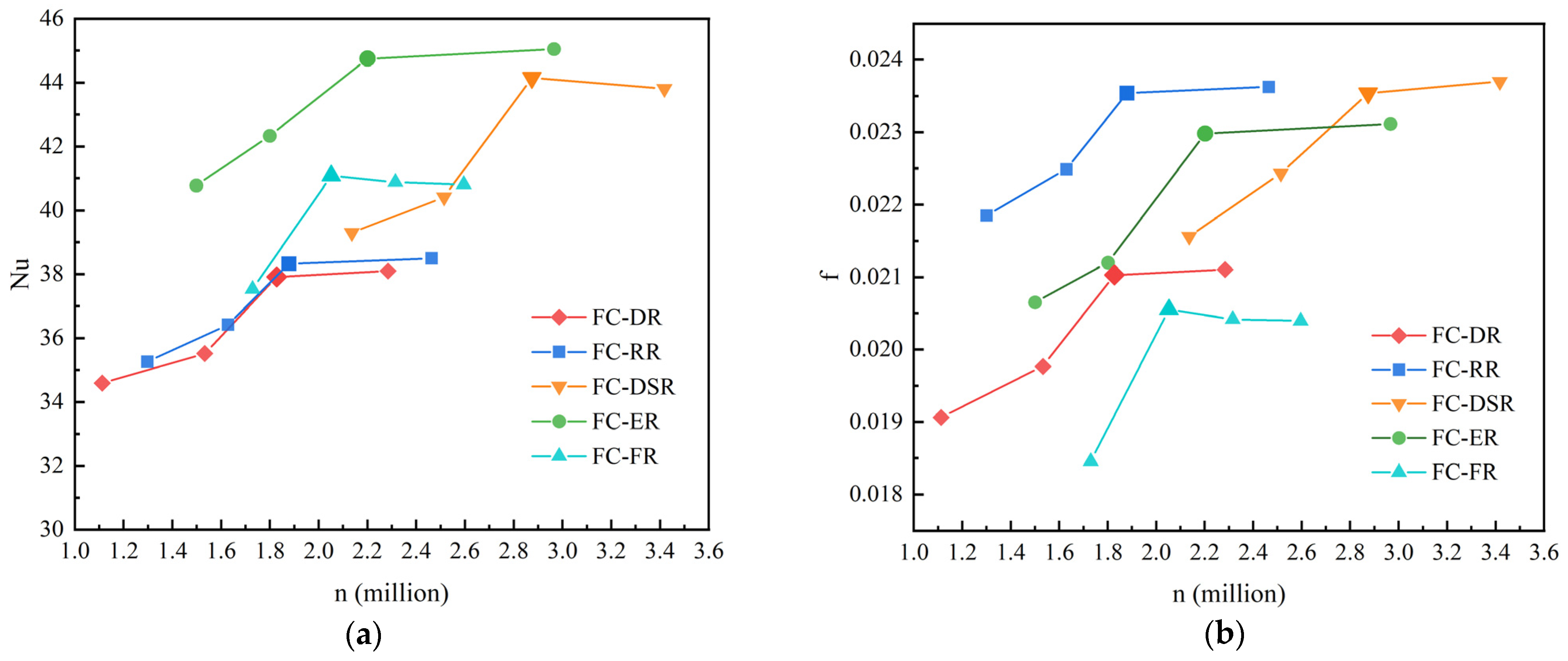

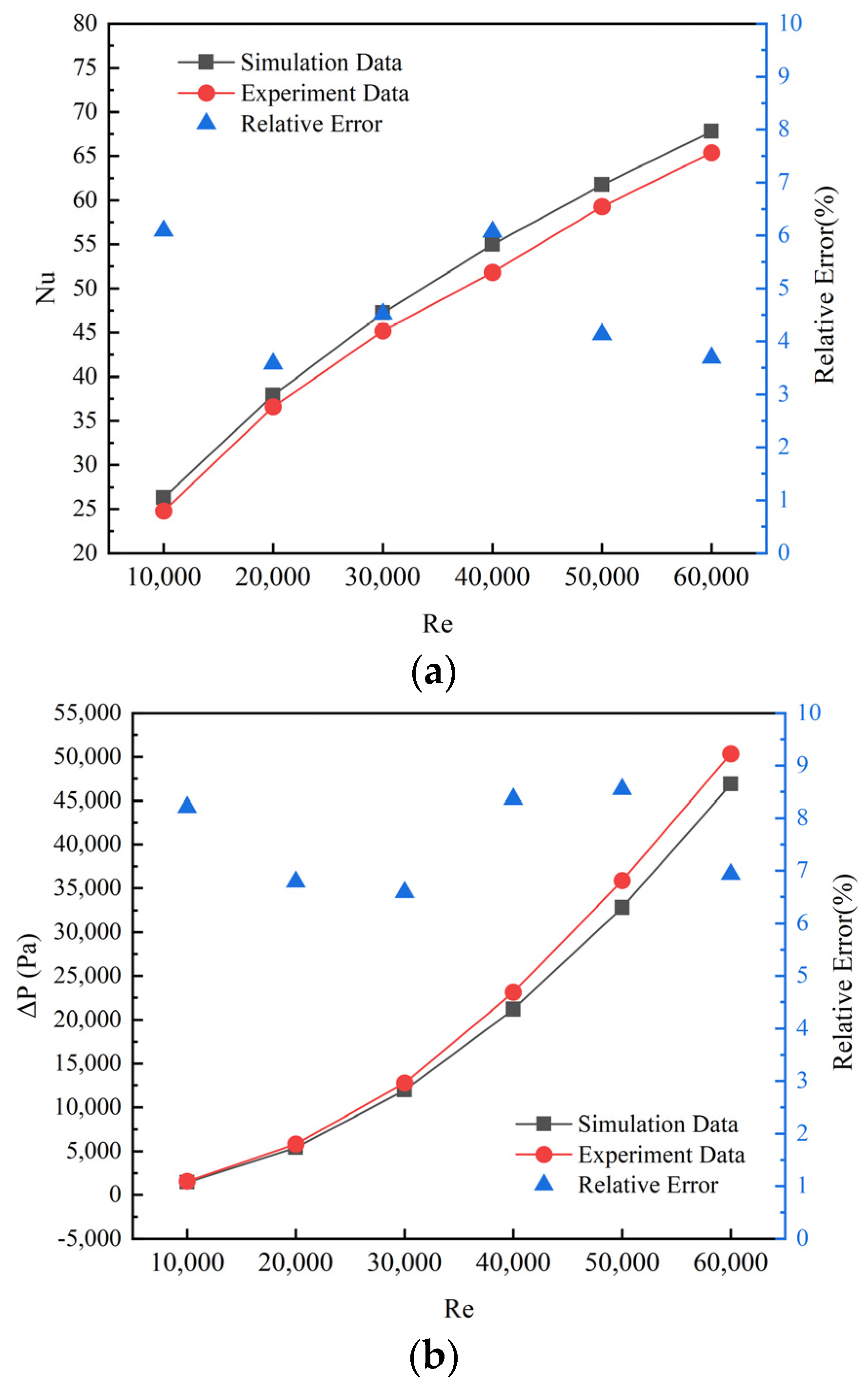
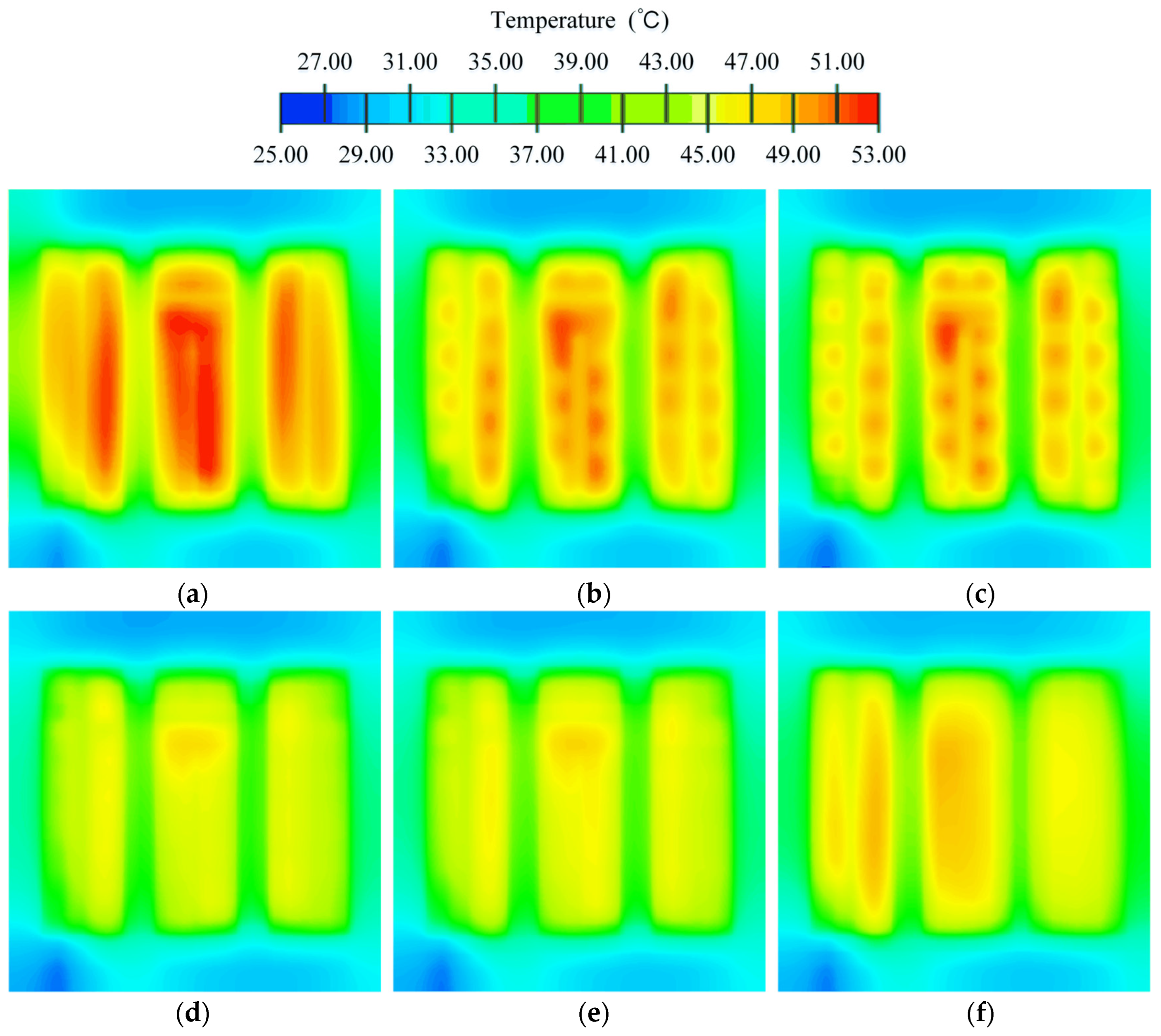
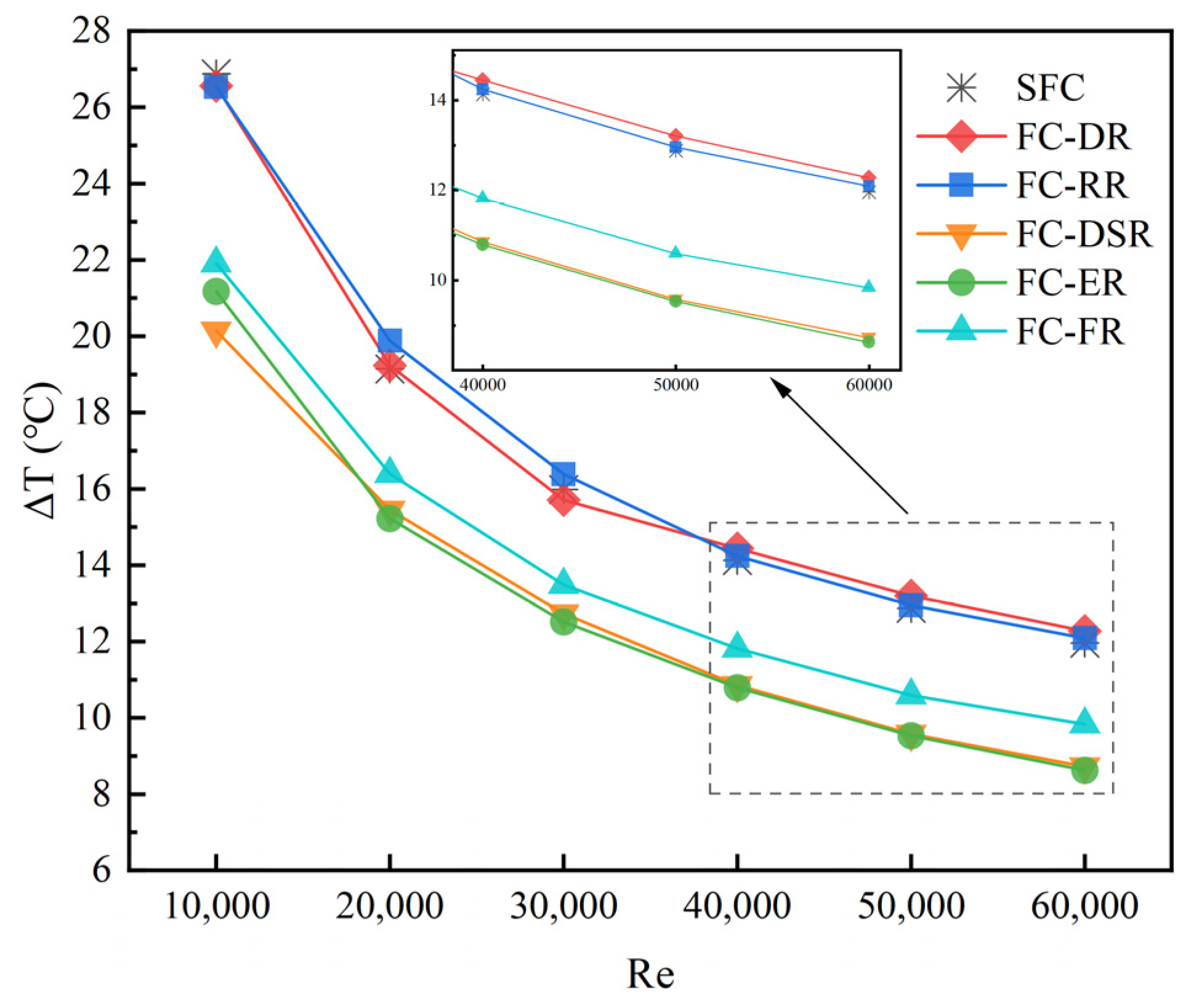

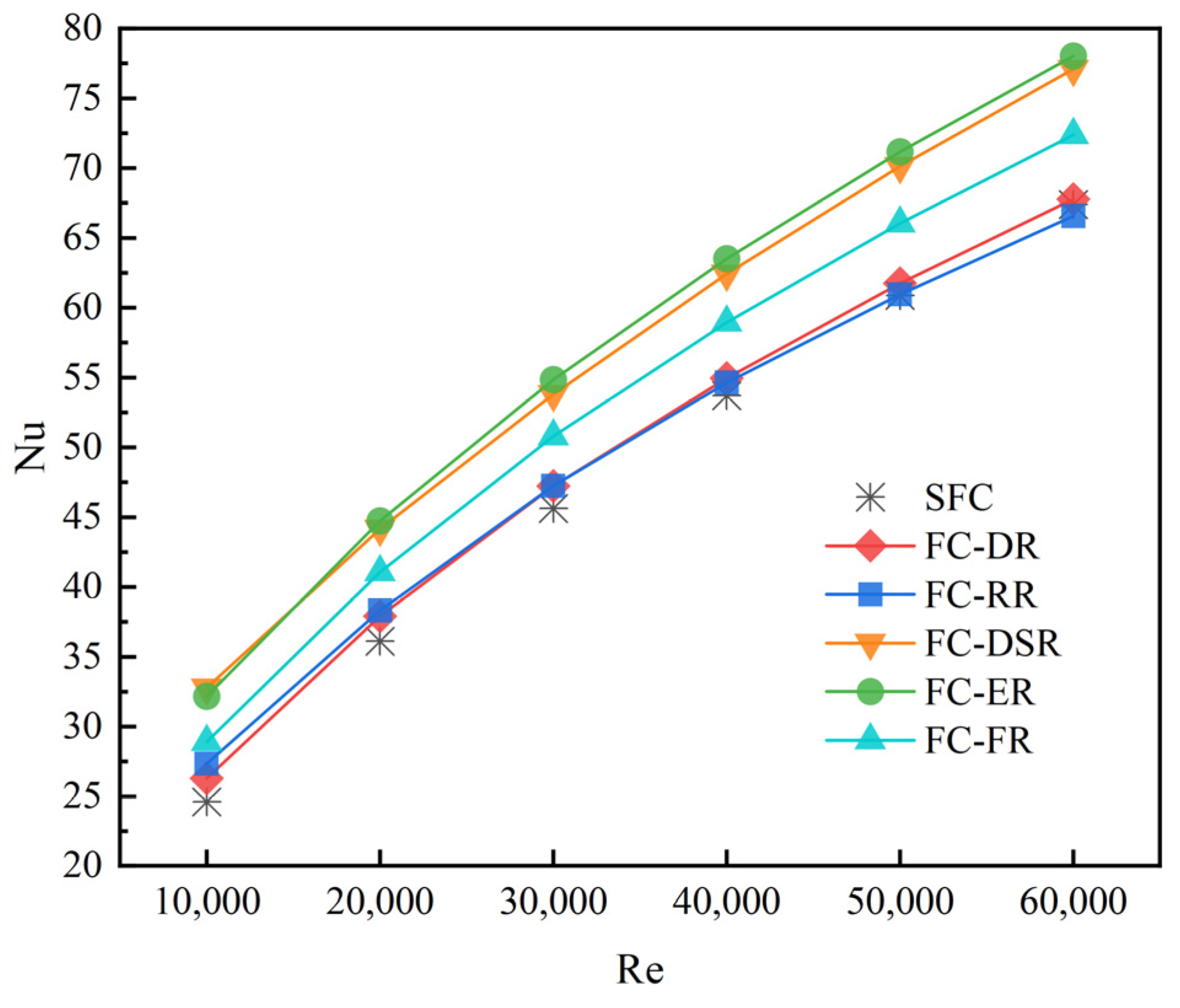


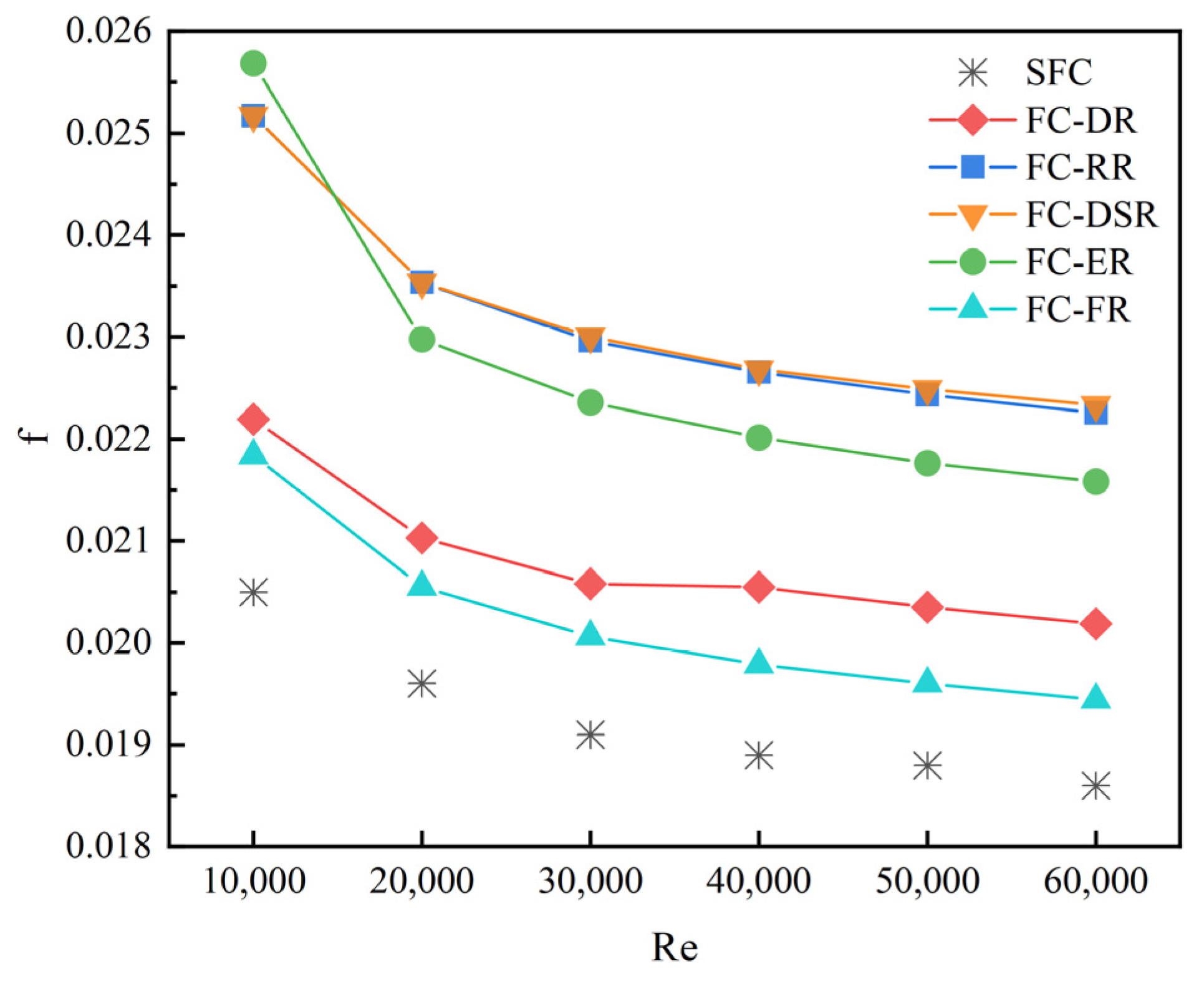

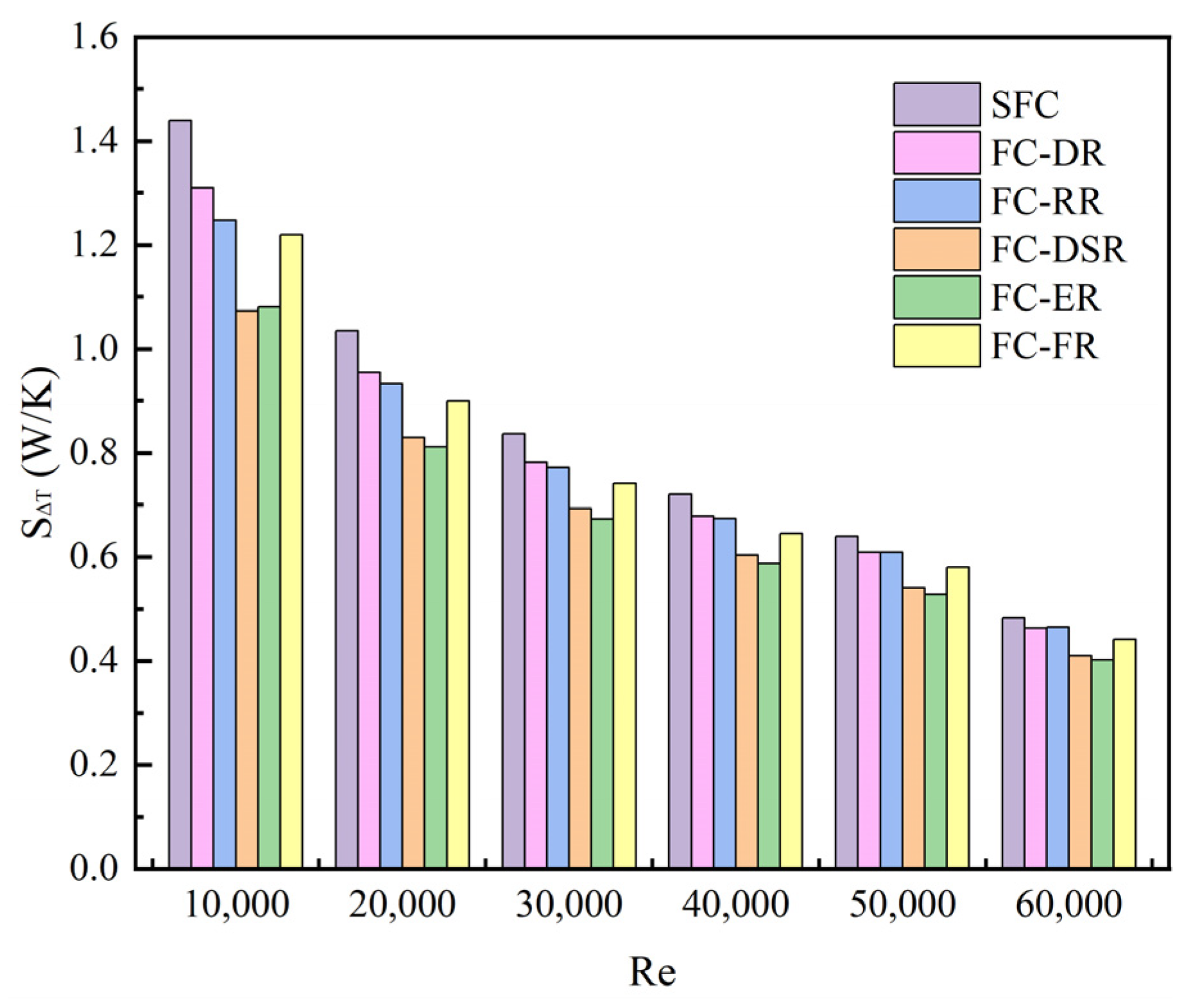
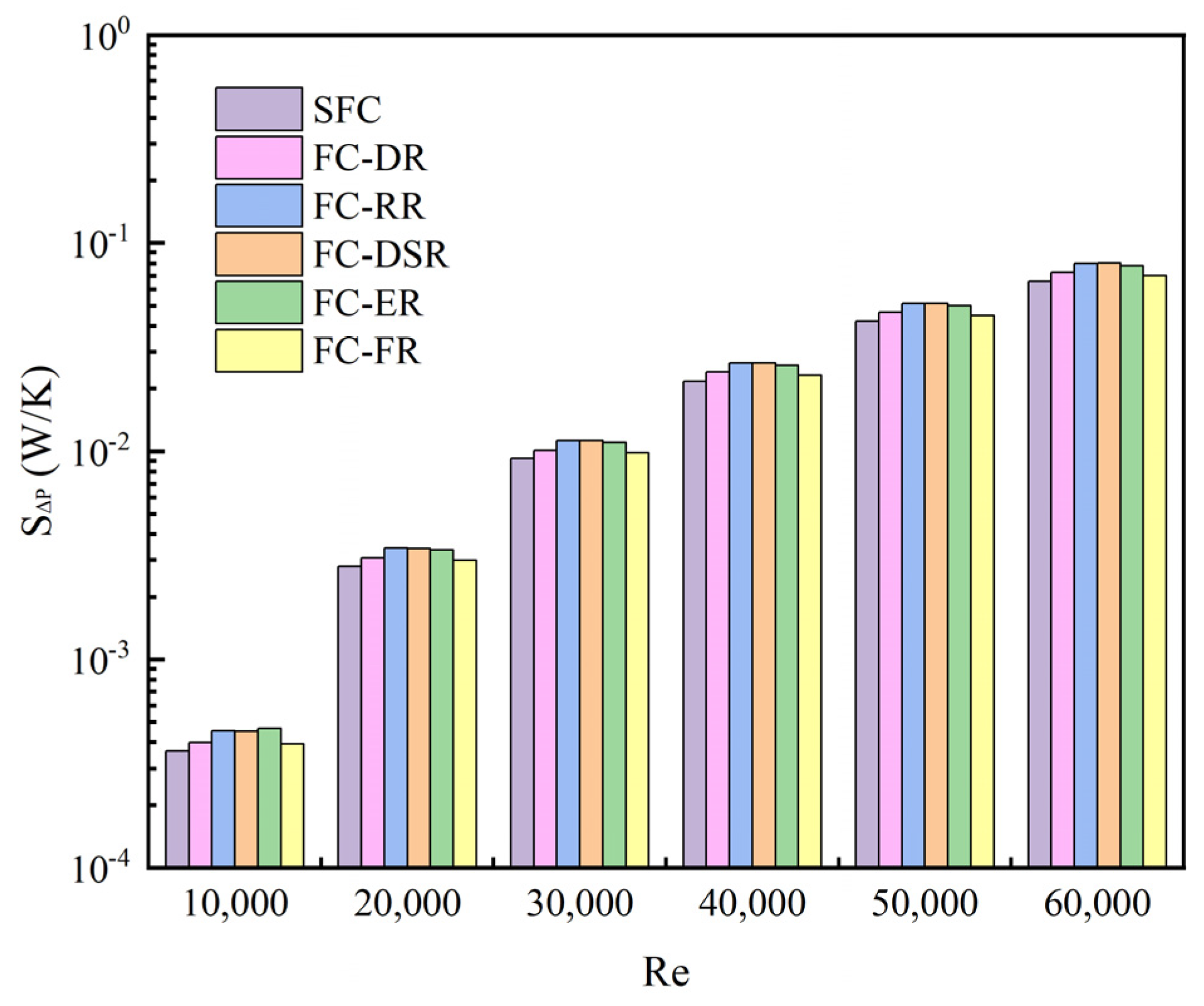

| Material | Density (kg/m3) | Specific Heat (kJ/(kg·k)) | Thermal Conductivity (w/m·k) | Dynamic viscosity (Ps·s) |
|---|---|---|---|---|
| 6063 Al | 2710 | 0.902 | 218 | - |
| Coolant | 997.0 | 4.2 | 0.609 | 9.028 × 10−4 |
Disclaimer/Publisher’s Note: The statements, opinions and data contained in all publications are solely those of the individual author(s) and contributor(s) and not of MDPI and/or the editor(s). MDPI and/or the editor(s) disclaim responsibility for any injury to people or property resulting from any ideas, methods, instructions or products referred to in the content. |
© 2024 by the authors. Licensee MDPI, Basel, Switzerland. This article is an open access article distributed under the terms and conditions of the Creative Commons Attribution (CC BY) license (https://creativecommons.org/licenses/by/4.0/).
Share and Cite
He, L.; Hu, X.; Zhang, L.; Chen, F.; Zhang, X. Performance Evaluation of a Double-Helical-Type-Channel Reinforced Heat Sink Based on Energy and Entropy-Generation Analysis. Processes 2024, 12, 598. https://doi.org/10.3390/pr12030598
He L, Hu X, Zhang L, Chen F, Zhang X. Performance Evaluation of a Double-Helical-Type-Channel Reinforced Heat Sink Based on Energy and Entropy-Generation Analysis. Processes. 2024; 12(3):598. https://doi.org/10.3390/pr12030598
Chicago/Turabian StyleHe, Liyi, Xue Hu, Lixin Zhang, Feng Chen, and Xinwang Zhang. 2024. "Performance Evaluation of a Double-Helical-Type-Channel Reinforced Heat Sink Based on Energy and Entropy-Generation Analysis" Processes 12, no. 3: 598. https://doi.org/10.3390/pr12030598
APA StyleHe, L., Hu, X., Zhang, L., Chen, F., & Zhang, X. (2024). Performance Evaluation of a Double-Helical-Type-Channel Reinforced Heat Sink Based on Energy and Entropy-Generation Analysis. Processes, 12(3), 598. https://doi.org/10.3390/pr12030598





